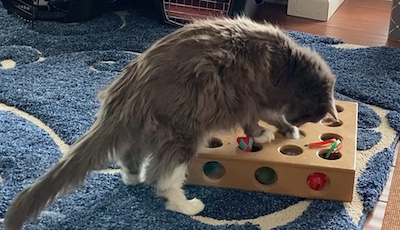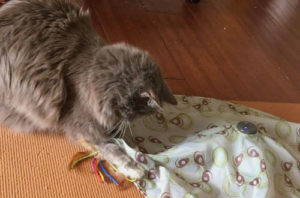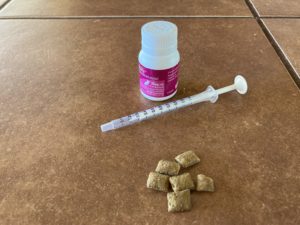
How do I know if my cat has a good quality of life? Take a minute and look at your cat’s life to see if the positive experiences outweigh the negative ones.
Quality of Life or QOL is just what it says – what is the quality of health, comfort and happiness experienced by an individual human or animal? Assessing QOL can help you decide which treatment to choose for a sick pet or help you improve your cat’s welfare.
QOL tends to come up when a pet is ill and euthanasia is being considered. Because of this association with end of life, evaluating quality of life is often neglected at other times in life.
When my older cat was not doing well recently, I was thinking about her QOL. It occurred to me that QOL is something that we should be aware of and assess regularly. It is a good idea to evaluate this when we feel our cat is healthy and happy so that we have a comparison for when he is sick, in pain, or feeling insecure or threatened.
If a cat has a good quality of life, he will have many positive experiences and have few negative experiences.
Let’s start with a cat’s basic needs…
- Every cat needs a safe place – somewhere she can go, away from other pets and humans
- He needs food, water and litter boxes that he can use without being interfered with by other cats, dogs or humans
- A stable environment allows a cat to feel confident and secure. This environment is predictable, without too much physical change, and offers opportunities for positive experiences, say outdoor access to a backyard.
- Interactions with humans and other pets should be pleasant and not frightening (so tell the kids not to run and shriek at the cat!)
- Your cat is a born hunter so he needs to have opportunities for predatory activity – either through play or foraging toys.
How do i know if my cat has a good quality of life?
In addition to the basic needs, what about the needs of the individual cat? Pain, emotional state, presence of strange humans and other pets or environmental stress can impact quality of life. Let’s look at the Quality of Life of 16 year old Athena.
positive experiences

- Athena sleeps at the foot of the bed or under the covers when it is cold.
- She likes the treats she gets before and after having her twice daily thyroid medication.
- She likes to scratch on the scratching posts – in the bedroom and by the door to the backyard.
- She will nap in her heated bed when it is cold or on the bed upstairs when it is warm.
- When the weather is nice, she will go out into the backyard.
- In the evenings, she enjoys a grooming session followed by some play with a fishing pole toy or laser pointer.
- Her day finishes up with some dental treats.
Negative experiences

- Athena gets another medication in the morning – a bitter liquid which she does not like.
- She does not like the other cats and prefers to avoid them
- She has arthritis and her joints hurt.
- Sometimes she is nauseated – she will approach her food, sniff it, but not eat.
Athena enjoys about 2 x as many positive experiences as negative experiences in her day. Although she suffers from arthritis pain and is not fond of other cats, she is still able to enjoy the positive things her environment offers her, such as going outdoors and engaging in predatory play. Overall, her QOL is good but here are some improvements.
- Giving food paste (for example, chicken baby food) before and after her bitter medication helps “get the bad taste out of her mouth”. We end the medicating process on a positive note with her favorite dry treats.
- So that Athena can avoid the other cats, she eats from her own microchip-controlled feeder. The other cats have learned that the feeder does not open for them.
- Athena receives an injection of joint protecting supplement to help alleviate her joint pain. She also has steps up to the bed and a heated bed to nap in.
- If she seems nauseated, she receives medication.
HOW DO I KNOW IF MY CAT HAS A GOOD QUALITY OF LIFE?
THE TAKEAWAY:
- You want your cat’s life to have more positive experiences than negative experiences.
- Make a list and see what the positive/negative balance is. Are there more positives than negatives? How can you improve things?
- Compare and update lists before you take your cat in for his annual or bi-annual vet exam.
- By being aware of your cat’s daily behaviors, you will be able to provide medical care and supportive care when needed, and preempt behavior issues.
Want to keep up with the world of cats? Click the button below and subscribe to The Feline Purrspective!



karen gifford says:
Hi Phyllis: It has been a while since I lost my boy Tobias (passed in 10/19) and with Marc being so ill I have not added to our family. Right now I am taking care of my neighbors cat,Tux, little love is over 100. She does will grooming, cuddling, eating (baby food mostly) and has one medication to keep her thyroid in balance. She likes to chase/saunter treats I toss out and gaze out windows (totally indoor kitty) at the wildlife. The one unusable behavior she does is what I would call “howling” and very loud. She does it at different times of day, her mom said this has been going on for some time. She does not appear to be in pain but I can tell she moves slowly and again according to her mom the vet says there is some arthritis. Is the this “howling” to get attention? Most times when I acknowledge her behavior she then quiets down. I would appreciate any information you could provide. Thank you.
Karen